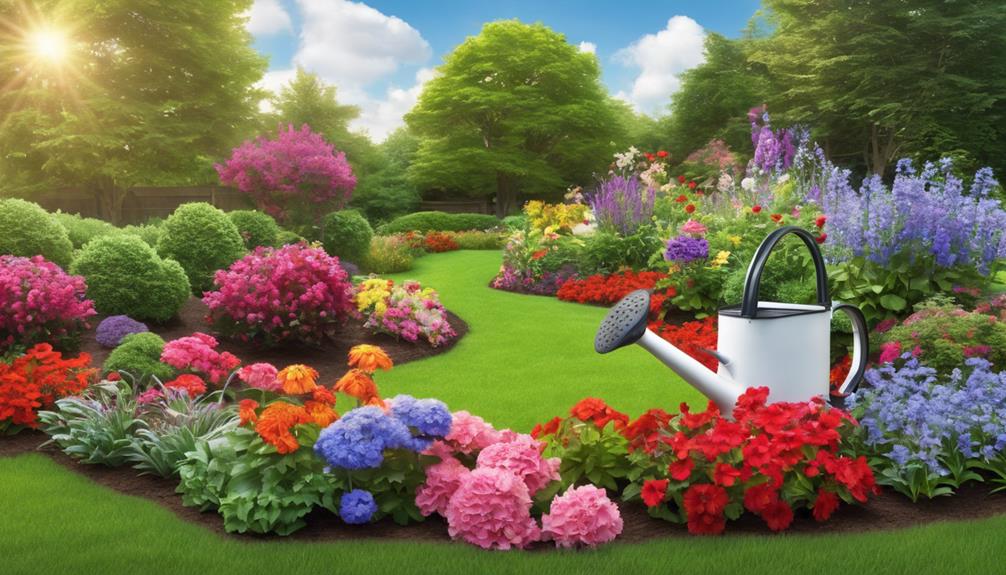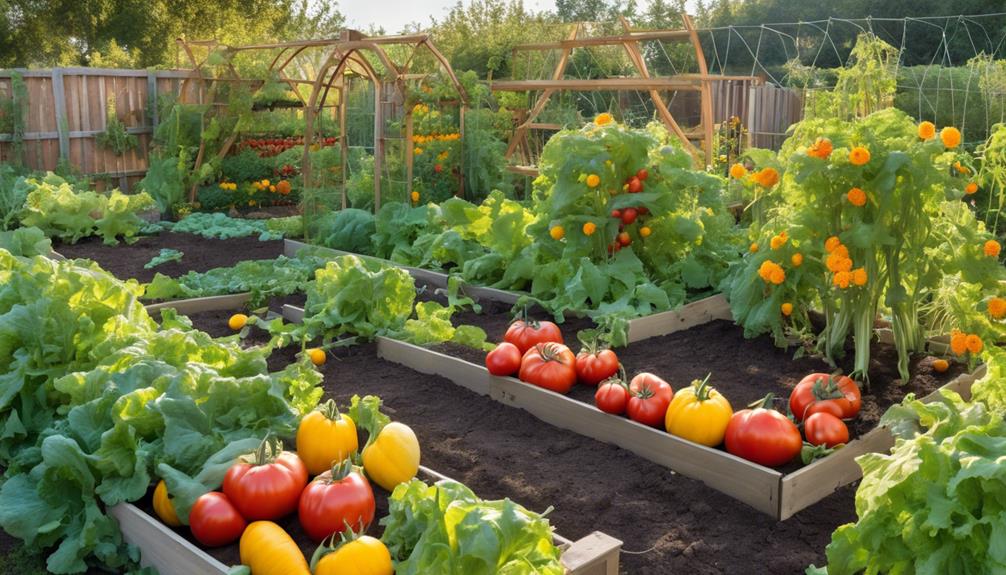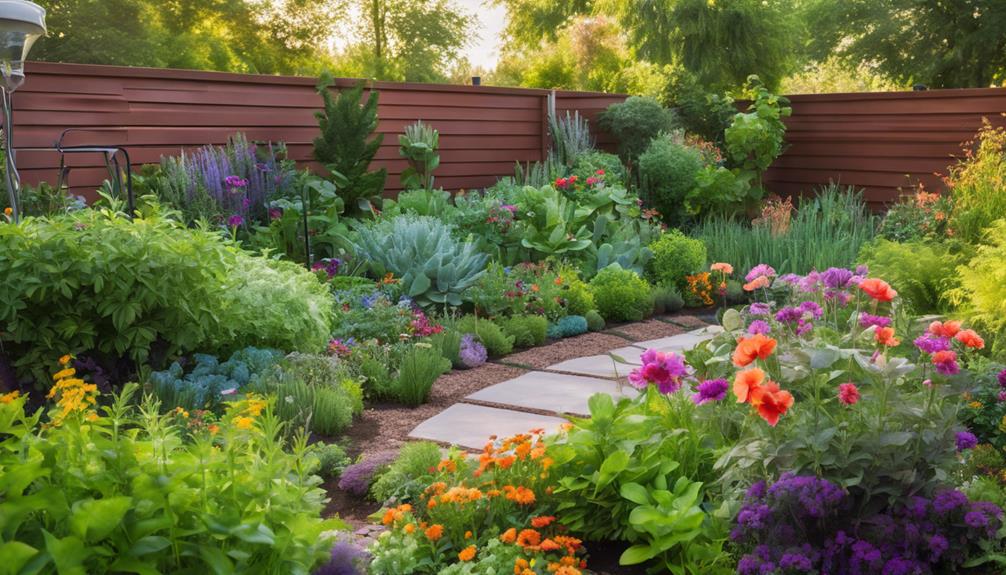
How to Install Fencing for Garden Security
24 January 2025
Sidewalk and Pathway Cleaning Quinton
24 January 2025Mastering flower garden care requires a solid understanding of fundamental maintenance practices.
Start by ensuring ideal soil quality through regular testing and organic amendments, which promote healthy growth.
Implement effective watering techniques, focusing on deep, infrequent watering to encourage strong root systems.
Seasonal planting strategies, such as timely fertilisation and selecting compatible flower varieties, improve bloom potential.
Pest management is vital; utilise preventive measures and consider introducing beneficial insects to maintain a balanced ecosystem.
With these foundational tips, you'll cultivate a thriving garden environment while uncovering strategies to further enhance your gardening success.
Garden Care Essentials Explained
Understanding soil quality and effective watering techniques is vital for maintaining a vibrant flower garden.
Healthy soil provides essential nutrients that support plant growth, while proper watering ensures that plants receive adequate moisture without the risk of over-saturation.
Together, these elements form the foundation of successful garden care.
Soil Quality Importance
Recognising the critical role of soil quality in a thriving flower garden is essential for any gardener seeking vibrant blooms and robust plant health.
Soil serves as the foundation for nutrient uptake, water retention, and root development. A balanced mix of organic matter, minerals, and microorganisms fosters an environment conducive to optimal growth.
Regular soil testing is necessary to determine pH levels and nutrient deficiencies, enabling targeted amendments that improve fertility. Furthermore, proper aeration and drainage prevent root rot and promote healthy root systems.
Implementing practices such as crop rotation and the incorporation of compost not only enriches the soil but also encourages biodiversity.
Ultimately, prioritising soil quality is a cornerstone of effective flower garden management, ensuring enduring beauty and resilience.
Watering Techniques Overview
Effective watering techniques are fundamental for maintaining a healthy flower garden, as they directly influence plant growth and blooming potential.
To master watering, it is important to understand the specific needs of your flowers, as different species have varying requirements. Deep, infrequent watering encourages root development, while shallow, frequent watering can lead to surface roots and poor drought resistance.
Timing is also essential; early morning is the best time to water, minimising evaporation and fungal diseases. Employing methods such as drip irrigation or soaker hoses can deliver moisture efficiently and sustainably.
Ultimately, always observe soil moisture levels, as overwatering can be just as detrimental as underwatering, ensuring your flowers thrive throughout the growing season.
Soil Quality and Composition
Soil quality and composition are crucial factors that directly influence the health and vigour of your flower garden.
Key considerations include enhancing pH levels, ensuring a balanced availability of indispensable nutrients, and effectively applying mulch to retain moisture and suppress weeds.
Ph Level Optimization
Achieving ideal pH levels is vital for maintaining high-quality soil that supports vibrant flower gardens. A balanced pH range of 6.0 to 7.0 promotes optimal nutrient availability, which directly influences plant health and growth.
To master pH level enhancement, consider the following key steps:
- Regular Testing: Conduct soil tests biannually to monitor pH fluctuations and adjust as necessary.
- Amendments: Use lime to raise pH or sulphur to lower it, ensuring your soil remains conducive to your specific flower varieties.
- Organic Matter: Incorporate compost to naturally buffer pH levels, enhancing soil structure and fertility.
Nutrient Balance and Availability
How can gardeners ensure their flowers thrive? Achieving ideal nutrient balance and availability in soil is paramount. Crucial nutrients such as nitrogen, phosphorus, and potassium must be present in appropriate proportions to foster vigorous growth and vibrant blooms.
To ascertain that your soil meets these requirements, consider the following:
- Conduct Regular Soil Tests: Assess nutrient levels and pH to identify deficiencies or excesses that may hinder plant health.
- Amend with Organic Matter: Incorporate compost or well-rotted manure to improve soil structure, enhancing nutrient retention and availability.
- Utilise Fertilisers Wisely: Choose fertilisers based on soil test results, applying them judiciously to avoid nutrient runoff and promote sustainable growth.
Mulch Application Techniques
Mulching is an essential practice that enhances soil quality and composition, providing numerous benefits for flower gardens. Proper mulch application not only improves aesthetics but also promotes healthy plant growth.
To achieve optimal results, consider the following techniques:
- Select the Right Material: Choose organic mulches, such as shredded bark or straw, to enrich the soil as they decompose.
- Apply at the Right Depth: Aim for a mulch layer of 5-7.5 centimetres to suppress weeds while allowing moisture penetration.
- Maintain Proper Distance from Stems: Keep mulch at least a few centimetres away from plant stems to prevent rot and pest issues.
Garden Tool Selection Guide
Selecting the appropriate garden tools is crucial for effective flower garden care.
Considerations such as choosing the right location for your garden, maintaining a consistent watering schedule, and implementing companion planting strategies can greatly influence your tool selection.
Choose the Right Location
When establishing a flower garden, understanding the significance of choosing the right location is paramount for ensuring the health and vibrancy of your plants. The ideal site not only fosters growth but also enhances the overall aesthetic of your garden.
Consider the following essential factors:
- Sunlight Exposure: Ensure your location receives adequate sunlight, as most flowering plants thrive in full sun for at least six hours each day.
- Soil Quality: Assess the soil's drainage and nutrient content; healthy soil is crucial for robust plant development.
- Protection from Elements: Select a sheltered area to shield your garden from harsh winds and extreme temperatures, promoting a stable environment.
Watering Schedule Consistency
Consistency in watering is essential for maintaining a thriving flower garden, as it directly influences plant health and growth.
A well-structured watering schedule guarantees that plants receive the necessary moisture, promoting robust blooms and lush foliage.
To master your watering routine, consider the following:
- Time of Day: Water early in the morning or late in the afternoon to minimise evaporation and allow plants to absorb moisture effectively.
- Soil Moisture Monitoring: Regularly check soil moisture levels to adjust your schedule, ensuring you neither under-water nor over-water.
- Seasonal Adjustments: Adapt your watering frequency based on seasonal changes, recognising that warmer months may require increased attention.
Companion Planting Strategies
Implementing companion planting strategies can significantly enhance the health and productivity of your flower garden. By carefully selecting neighbouring plants, you can promote growth, deter pests, and create a harmonious ecosystem.
Consider these effective strategies:
- Pest Deterrence: Certain flowers, such as marigolds, repel harmful insects, thereby reducing the need for chemical interventions.
- Nutrient Sharing: Plants like clover enrich the soil with nitrogen, benefiting neighbouring flowers and promoting robust growth.
- Attracting Beneficial Insects: Flowers such as dill and fennel attract pollinators and predatory insects, fostering a balanced environment.
Enhanced Plant Growth Potential
To achieve enhanced plant growth potential, it is crucial to comprehend the specific requirements of each plant species in your garden. Customising care practices such as watering, fertilisation, and light exposure can significantly improve growth outcomes. Implementing a systematic approach to monitoring these factors will yield optimal results.
| Plant Species | Growth Requirement |
|---|---|
| Roses | Full sun, well-drained soil |
| Lavender | Dry soil, full sun |
| Hydrangeas | Moist, well-drained soil |
| Sunflowers | Full sun, moderate watering |
Seasonal Planting Techniques
Understanding seasonal planting techniques is crucial for optimising the health and productivity of your flower garden.
Key considerations include the timing and application of fertilisers, the effective use of organic compost, and strategic pest control methods tailored to each season.
Fertilizer Timing and Techniques
Effective fertilisation is crucial for maximising the health and vigour of your flower garden throughout the growing seasons. Understanding the timing and techniques of fertilisation can greatly improve your plants' growth and flowering potential.
- Early Spring: Apply a balanced fertiliser as new growth appears, providing vital nutrients for robust development.
- Mid-Summer: A second application of slow-release fertiliser will sustain blooming during peak flower production, revitalising your plants.
- Autumn: Use a phosphorus-rich fertiliser to prepare your garden for dormancy, ensuring strong root development for the following spring.
Mastering these fertilisation techniques will empower you to cultivate a breathtaking floral display, boosting your garden's beauty and resilience.
Adopt this knowledge to nurture your passion for flower gardening effectively.
Organic Compost Application Tips
Incorporating organic compost into your flower garden can significantly enhance soil health and promote plant growth; however, the timing and application techniques are crucial for achieving optimal results.
To maximise the benefits of organic compost, consider the following essential tips:
- Seasonal Timing: Apply compost in early spring or autumn to align with plant growth cycles, ensuring nutrients are available when they are most needed.
- Layering Technique: Spread a 2.5-5 cm layer of compost evenly across the soil surface, allowing for ideal integration and moisture retention.
- Incorporation Method: Gently till the compost into the soil to improve aeration and microbial activity, fostering a thriving ecosystem for your plants.
Pest Control Application Methods
Maintaining a vibrant flower garden requires not only enriching the soil with organic compost but also implementing effective pest control methods that align with seasonal planting techniques.
Understanding the lifecycle of pests and the timing of your planting can significantly improve your garden's health and resilience.
Consider these crucial pest control application methods:
- Preventive Sprays: Utilise natural insecticidal soaps or neem oil early in the season to deter pests before they establish themselves.
- Companion Planting: Integrate pest-repellent plants, such as marigolds, to naturally ward off harmful insects while supporting neighbouring flora.
- Regular Monitoring: Conduct weekly inspections to identify signs of pest activity, enabling prompt intervention and minimising damage.
Pest Infestation Remedies
Effective management of pest infestations in flower gardens can be achieved through several strategies.
Introducing natural predators, planting flowers that attract beneficial insects, and employing integrated pest management techniques are all essential approaches.
These methods not only protect your plants but also promote a healthy garden ecosystem.
Natural Predators Introduction
Harnessing nature's own defences can be one of the most effective strategies for managing pest infestations in flower gardens.
Introducing natural predators into your ecosystem not only mitigates pest damage but also fosters a balanced environment. To enhance the effectiveness of these beneficial allies, consider the following:
- Ladybirds: Known for their voracious appetite for aphids, they can drastically reduce pest populations.
- Lacewings: Their larvae consume a variety of soft-bodied insects, including thrips and spider mites, providing robust pest control.
- Parasitic Wasps: These tiny wasps lay their eggs inside pest larvae, effectively controlling populations of caterpillars and other harmful insects.
Beneficial Insect Attracting Plants
Incorporating beneficial insect-attracting plants into your flower garden is a strategic approach to enhancing pest management and promoting biodiversity.
These plants create a hospitable environment for natural predators, which are essential for keeping pests under control.
Consider the following key species to enrich your garden:
- Marigolds: Their vibrant blooms attract ladybirds and lacewings, both effective hunters of aphids.
- Yarrow: This perennial not only beautifies your space but also draws in predatory wasps that help manage caterpillar populations.
- Borage: Known for attracting bees, its presence improves pollination, benefiting the overall health of plants.
Integrated Pest Management Techniques
Creating a diverse ecosystem with beneficial insect-attracting plants lays the groundwork for effective pest management. Integrated Pest Management (IPM) techniques focus on long-term prevention and control of pest populations while minimising harm to the environment.
By implementing strategic practices, gardeners can maintain their flower gardens with resilience.
- Regular Monitoring: Vigilantly observe plants for signs of pests, ensuring early detection and intervention.
- Cultural Practices: Rotate crops and select resistant varieties to disrupt pest life cycles and improve plant health.
- Biological Controls: Introduce natural predators, such as ladybirds or lacewings, to combat pest populations effectively.
These techniques empower gardeners to cultivate flourishing gardens while mastering the art of pest control sustainably.
Why Choose TKL Birmingham Gardener
When selecting a gardening service, TKL Birmingham Gardener stands out for its commitment to excellence and customer satisfaction.
Their team of skilled horticulturists possesses extensive knowledge of various gardening techniques, ensuring that your flower garden thrives throughout the seasons.
TKL Birmingham Gardener employs sustainable practices tailored to each garden's unique needs, promoting health and vibrancy while minimising environmental impact.
Their personalised approach fosters a deep understanding of your gardening goals, allowing them to deliver exceptional results.
Additionally, their transparent communication and dedication to ongoing education guarantee that clients are well-informed and empowered to make the best decisions for their gardens.
Choosing TKL Birmingham Gardener not only enhances your garden's beauty but also elevates your gardening experience to a new level of mastery.
Common Gardening Myths Debunked
Gardening is often surrounded by a web of misconceptions that can mislead both novice and experienced gardeners alike.
One prevalent myth is that more water equates to healthier plants; in reality, overwatering can lead to root rot and other issues.
Another common belief is that all organic gardening is pesticide-free, when in fact, organic pesticides do exist and can be effective.
Furthermore, many assume that pruning should only be done in spring; however, certain plants benefit from autumn pruning to promote growth.
Finally, the idea that all weeds are harmful overlooks the fact that some can attract beneficial insects.
Future Garden Planning Strategies
Understanding the realities of gardening can significantly enhance future planning efforts. Anticipating challenges and aligning your strategy with the unique needs of your environment will elevate your gardening experience to new heights.
Here are three crucial strategies for effective future garden planning:
- Soil Assessment: Regularly test soil health to ensure optimal nutrient levels and pH balance, fostering vigorous plant growth.
- Seasonal Planting: Strategically select plants based on seasonal compatibility, promoting resilience and minimising pest impact.
- Diversity in Plant Selection: Incorporate a variety of species to create a balanced ecosystem, enhancing pollination and reducing the spread of disease.




